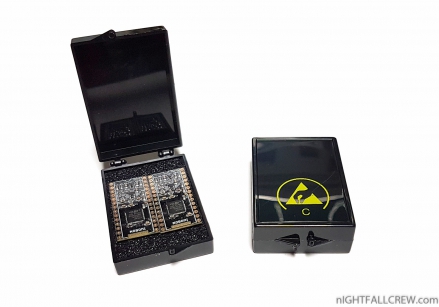ARMSiD (6581/8580 Replacement) by Nobomi

ARMSid (6581/8580 Replacement) by Nobomi.
Non ho resistito alla tentazione e ho voluto provare anche questa nuova emulazione del SID 6581/8580 con l’STM32F410 ARM Cortex M4, sto parlando dell’ARMSid di Nobomi.
La spedizione veloce e la cortesia di Nobomi sono sicuramente il punto forte, ma anche la confezione, l’integrato ARMSid viene spedito in un contenitore di plastica onde evitare qualsiasi problema con la spedizione.
Il suono e il feeling “sonoro” sono buoni come lo era per lo SwinSID Ultimate ma meglio, personalmente collocherei l’ARMSid come fedelta’ di emulazione tra il SID Originale e il SwinSID Ultimate, Nobomi sei stato molto bravo, complimenti.
Nobomi inoltre ha scritto un software per Commodore 64 per configurare le varie opzioni dell’ARMSid e un’altro software per aggiornare il Firmware.
Alcune informazioni prese dal sito di Nobomi in Inglese:
What is it ?:
- A new replacement of the MOS6581 and MOS8580 used in the Commodore C64. It is minimalistic (in simplicity of circuit and use, not in function and power).
- Real “plug & play” solution. Just insert instead of the original SID into the slot and it’s done.
- It determines (through supply voltages) which chip it replaces and starts the appropriate emulation (it can be changed later in software).
- No need to switch the PAL / NTSC version, the circuit uses directly the clock from the computer bus, always synchronous with the C64.
- It also emulates analog inputs (joysticks, mouse, etc. – POTX and POTY inputs)
- Analog output is sufficiently buffered, it is not necessary to change anything on the computer board for proper operation.
- Output sampling frequency is 1/16th bus clock of C64 (approx. 62kHz), real 12bit D/A converter, no pwm.
- Filters completely transferred to digital form, emulated by float point arithmetic.
- Significantly lower noise level and less interference from the power supply than the original :)
- Lower power consumption than the original.
- Firmware update possible inside the C64.
- Emulates all waveforms, and even “samples” (at least some of them, Ghostbusters laugh, Chimera screams at you).
- Full support of analog filters (LowPass, BandPass, HighPass, combination, Q quality control).
- Emulation of OSC3 and ENV3 registers (little delay, approximately 16 clocks of the C64 bus).
- Joysticks and mice work.
What is inside ?:
- A few resistors, capacitors, one stabilizer, one opamp and a processor. That’s all, parts only from one side.
- The only programmable circuit is the STM32F410, ARM Cortex M4 with HW float point arithmetic at 100MHz.
- Analogue output amplified via the AD8515 opamp.
- Stabilizer for the 3.3V processor, the processor itself has 5V tolerance inputs.
Firmware:
- New features in FW 2.6:
- Optimization for speed again (approx. 10ns more faster response to read registers, faster processing of writing registers).
- New features in FW 2.5:
- Again faster interrupt (approx. 10ns more faster response to read registers).
- New features in FW 2.4:
- Further optimization of the interrupt (approx. 20ns faster response to read registers).
- New features in FW 2.3:
- A part of source code (interrupt routine) has been rewritten in assembler and manually optimized.
- It makes a possibility to control the bus only through the CS signal (no need for O2 clock synchronization, so it can run on systems with a different CPU than MOS6502 now).
- Low frequency limit and filter strength settings and saving settings to permanent flash memory.
Gallery:
Download:
ARMSiD Video:
source: ARMSiD Homepage









This is amazing and very much needed. Is there a gerber or a list of parts available?